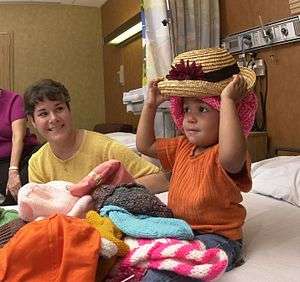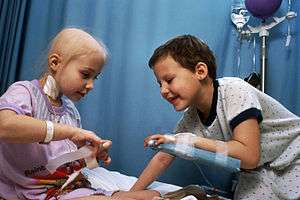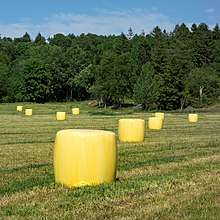Childhood cancer
Childhood cancer is cancer in a child. In the United States, an arbitrarily adopted standard of the ages used are 0–14 years inclusive, that is, up to 14 years 11.9 months of age.[2][3] However, the definition of childhood cancer sometimes includes adolescents between 15–19 years old.[3] Pediatric oncology is the branch of medicine concerned with the diagnosis and treatment of cancer in children.
| Childhood cancer | |
|---|---|
| Other names | Pediatric cancer |
 | |
| A girl trying out hats to wear after chemotherapy against a Wilms' tumor[1] | |
| Specialty | Pediatrics, oncology |
Worldwide, it is estimated that childhood cancer has an incidence of more than 175,000 per year, and a mortality rate of approximately 96,000 per year.[4] In developed countries, childhood cancer has a mortality of approximately 20% of cases.[5] In low resource settings, on the other hand, mortality is approximately 80%, or even 90% in the world's poorest countries.[5] In many developed countries the incidence is slowly increasing, as rates of childhood cancer increased by 0.6% per year between 1975 and 2002 in the United States[6] and by 1.1% per year between 1978 and 1997 in Europe.[7]
Signs and symptoms
Learning problems
Children with cancer are at risk for developing various cognitive or learning problems.[8] These difficulties may be related to brain injury stemming from the cancer itself, such as a brain tumor or central nervous system metastasis or from side effects of cancer treatments such as chemotherapy and radiation therapy. Studies have shown that chemo and radiation therapies may damage brain white matter and disrupt brain activity.
This cognitive problem is known as post-chemotherapy cognitive impairment (PCCI) or "chemo brain." This term is commonly use by cancer survivors who describe having thinking and memory problems after cancer treatment.[9] Researchers are unsure what exactly causes chemo brain, however, they say it is likely to be linked to either the cancer itself, the cancer treatment, or be an emotional reaction to both.[9]
This cognitive impairment is commonly noticed a few years after a child endures cancer treatment. When a childhood cancer survivor goes back to school, they might experience lower test scores, problems with memory, attention, and behavior, as well as poor hand-eye coordination and slowed development over time.[10] Parents can apply their children for special educational services at school if their cognitive learning disability affects their educational success.[11]
Risk factors
Familial and genetic factors are identified in 5-15% of childhood cancer cases. In <5-10% of cases, there are known environmental exposures and exogenous factors, such as prenatal exposure to tobacco, X-rays, or certain medications.[12] For the remaining 75-90% of cases, however, the individual causes remain unknown.[12] In most cases, as in carcinogenesis in general, the cancers are assumed to involve multiple risk factors and variables.[13]
Aspects that make the risk factors of childhood cancer different from those seen in adult cancers include:[14]
- Different, and sometimes unique, exposures to environmental hazards. Children must often rely on adults to protect them from toxic environmental agents.
- Immature physiological systems to clear or metabolize environmental substances
- The growth and development of children in phases known as "developmental windows" result in certain "critical windows of vulnerability".
Also, a longer life expectancy in children avails for a longer time to manifest cancer processes with long latency periods, increasing the risk of developing some cancer types later in life.[14]
Advanced parental age has been associated with increased risk of childhood cancer in the offspring.[15] There are preventable causes of childhood malignancy, such as delivery overuse and misuse of ionizing radiation through computed tomography scans when the test is not indicated or when adult protocols are used.[16][17]
Diagnosis
Types

The most common cancers in children are (childhood) leukemia (32%), brain tumors (18%), and lymphomas (11%).[7][18] In 2005, 4.1 of every 100,000 young people under 20 years of age in the U.S. were diagnosed with leukemia, and 0.8 per 100,000 died from it.[19] The number of new cases was highest among the 1–4 age group, but the number of deaths was highest among the 10–14 age group.[19]
In 2005, 2.9 of every 100,000 people 0–19 years of age were found to have cancer of the brain or central nervous system, and 0.7 per 100,000 died from it.[19] These cancers were found most often in children between 1 and 4 years of age, but the most deaths occurred among those aged 5–9.[19] The main subtypes of brain and central nervous system tumors in children are: astrocytoma, brain stem glioma, craniopharyngioma, desmoplastic infantile ganglioglioma, ependymoma, high-grade glioma, medulloblastoma and atypical teratoid rhabdoid tumor.[20]
Other, less common childhood cancer types are:[20][18]
- Neuroblastoma (6%, nervous system)
- Wilms tumor (5%, kidney)
- Non-Hodgkin lymphoma (4%, blood)
- Childhood rhabdomyosarcoma (3%, many sites)
- Retinoblastoma (3%, eye)
- Osteosarcoma (3%, bone cancer)
- Ewing sarcoma (1%, many sites)
- Germ cell tumors (5%, many sites)
- Pleuropulmonary blastoma (lung or pleural cavity)
- Hepatoblastoma and hepatocellular carcinoma (liver cancer)
Prognosis
Adult survivors of childhood cancer have some physical, psychological, and social difficulties.
Premature heart disease is a major long-term complication in adult survivors of childhood cancer.[21] Adult survivors are eight times more likely to die of heart disease than other people, and more than half of children treated for cancer develop some type of cardiac abnormality, although this may be asymptomatic or too mild to qualify for a clinical diagnosis of heart disease.[21]
Childhood cancer survivors are also at risk of developing adverse effects on the kidneys [22] and the liver [23]. The risk of liver late adverse effects in childhood cancer survivors is increased in those who have had radiotherapy to the liver and in people with factors such as higher body mass index and chronic viral hepatitis.[23] Certain treatments and liver surgery may also increase the risk of adverse liver effects in childhood cancer survivors.[23]
Epidemiology
Internationally, the greatest variation in childhood cancer incidence occurs when comparing high-income countries to low-income ones.[24] This may result from differences in being able to diagnose cancer, differences in risk among different ethnic or racial population subgroups, as well as differences in risk factors.[24] An example of differing risk factors is in cases of pediatric Burkitt lymphoma, a form of non-Hodgkin lymphoma that sickens 6 to 7 children out of every 100,000 annually in parts of sub-Saharan Africa, where it is associated with a history of infection by both Epstein-Barr virus and malaria.[24][25][26] In industrialized countries, Burkitt lymphoma is not associated with these infectious conditions.[24]
US
In the United States, cancer is the second most common cause of death among children between the ages of 1 and 14 years, exceeded only by accidents.[19] More than 16 out of every 100,000 children and teens in the U.S. were diagnosed with cancer, and nearly 3 of every 100,000 died from the disease.[19] In the United States in 2012, it was estimated that there was an incidence of 12,000 new cases, and 1,300 deaths, from cancer among children 0 to 14 years of age.[27] Statistics from the 2014 American Cancer Society report:
Ages birth to 14[28]
| Sex | Incidence | Mortality | Observed Survival % |
|---|---|---|---|
| Boys | 178.0 | 23.3 | 81.3 |
| Girls | 160.1 | 21.1 | 82.0 |
Ages 15 to 19[28]
| Sex | Incidence | Mortality | Observed Survival % |
|---|---|---|---|
| Boys | 237.7 | 34.5 | 80.0 |
| Girls | 235.5 | 24.7 | 85.4 |
Note: Incidence and mortality rates are per 1,000,000 and age-adjusted to the 2000 US standard population. Observed survival percentage is based on data from 2003-2009.
UK
Cancer in children is rare in the UK, with an average of 1,800 diagnosis every year but contributing to less than 1% of all cancer related deaths.[29] Age is not a confounding factor in mortality from the disease in the UK. From 2014-2016, approximately 230 children died from cancer, with Brain/CNS cancers being the most common culprit.
Foundations and fundraising

Currently, there are various organizations whose sole focus is fighting childhood cancer. Organizations focused on childhood cancer through cancer research and/or support programs include: Childhood Cancer Canada, CLIC Sargent and the Children's Cancer and Leukaemia Group (in United Kingdom), Child Cancer Foundation (in New Zealand), Children's Cancer Recovery Foundation (in United States),[30] American Childhood Cancer Organization (in United States),[31] Childhood Cancer Support (Australia) and the Hayim Association (in Israel).[32] Alex's Lemonade Stand Foundation allows people across the US to raise money for pediatric cancer research by organizing lemonade stands.[33] The National Pediatric Cancer Foundation focuses on finding less toxic and more effective treatments for pediatric cancers. This foundation works with 24 different hospitals across the US in search of treatments effective in practice.[34] Childhood Cancer International is the largest global pediatric cancer foundation. It focuses on early access to care for childhood cancers, focusing on patient support and patient advocacy.[35]
According to estimates by experts in the field of pediatric cancer, by 2020, cancer will cost $158 million annually for both research and treatment which marks a 27% increase since 2010.[36] Ways in which the foundations are helped by people include writing checks, collecting spare coins, bake/lemonade sales, donating potions of purchases from stores or restaurants, or Paid Time Off donations[37] as well as auctions, bike rides, dance-a-thons. Additionally, many of the major foundations have donation buttons.
In addition to advancing research focusing on cancer, the foundations also offer support to families whose children are afflicted by the disease. Support groups are offered both in hospitals and online and are funded by the different foundations.[38] The foundations for pediatric cancers organize in-person and online support groups and direct families toward books that aid in the coping process. The foundations for pediatric cancer all fall under the 501(c)3 designation which means that they are non-profit organizations that are tax-exempt.[39] The "International Childhood Cancer Day" occurs annually on February 15.[5][40]
References
- EBSCO database verified by URAC; accessed from Mount Sinai Hospital, New York
- Bahadur G, Hindmarsh P (January 2000). "Age definitions, childhood and adolescent cancers in relation to reproductive issues". Human Reproduction. 15 (1): 227. doi:10.1093/humrep/15.1.227. PMID 10611218.
- Childhood Cancers: Basic Facts & Figures from Minnesota Department of Health. Retrieved Dec, 2012
- About childhood cancer at Childhood Cancer 2012, by Children With Cancer UK
- International Childhood Cancer Day – 15 February 2013 Archived 20 November 2016 at the Wayback Machine at educationscotland.gov.uk. Retrieved Dec, 2012
- Ward EM, Thun MJ, Hannan LM, Jemal A (September 2006). "Interpreting cancer trends". Annals of the New York Academy of Sciences. 1076 (1): 29–53. Bibcode:2006NYASA1076...29W. doi:10.1196/annals.1371.048. PMID 17119192.
- Kaatsch P (June 2010). "Epidemiology of childhood cancer". Cancer Treatment Reviews. 36 (4): 277–85. doi:10.1016/j.ctrv.2010.02.003. PMID 20231056.
- Children Diagnosed With Cancer: Returning to School from American Cancer Society. Last Medical Review: 07/02/2012
- "Chemo Brain". Mayo Clinic. Mayo Foundation for Medical Education and Research. Retrieved 2019-03-19.
- "Late Effects of Childhood Cancer Treatment". American Cancer Society. American Cancer Society Inc. Retrieved 2019-03-19.
- "Learning Problem After Treatment". Children's Oncology Group. The Children's Oncology Group. Retrieved 2019-03-19.
- Children and Cancer, in Children's Health and the Environment, a WHO Training Package for the Health Sector, World Health Organization. In turn citing:
- Birch JM. Genes & Cancer" Arch Dis Child 1999, 80:1-3.
- Lichtenstein P et al" N Engl J Med 2000, 13;343(2) 78-85
- Children and Cancer, in Children's Health and the Environment, a WHO Training Package for the Health Sector, World Health Organization. In turn citing: Anderson LM et al. Critical Windows of Exposure for Children’s Health: Cancer in Human Epidemiological Studies and Neoplasms in Experimental Animals Models. Environ Health Perspect, 2000, 108(suppl 3) 573-594.
- Children and Cancer, in Children's Health and the Environment, a WHO Training Package for the Health Sector, World Health Organization.
- Johnson KJ, Carozza SE, Chow EJ, Fox EE, Horel S, McLaughlin CC, et al. (July 2009). "Parental age and risk of childhood cancer: a pooled analysis". Epidemiology. 20 (4): 475–83. doi:10.1097/EDE.0b013e3181a5a332. PMC 2738598. PMID 19373093.
- "Radiology Safety - What can I do?". Image Gently. Alliance for Radiation Safety in Pediatric Imaging. Retrieved 8 February 2016.
- Swensen SJ, Duncan JR, Gibson R, Muething SE, LeBuhn R, Rexford J, et al. (September 2014). "An appeal for safe and appropriate imaging of children". Journal of Patient Safety. 10 (3): 121–4. doi:10.1097/PTS.0000000000000116. PMID 24988212.
- "UpToDate".
- Cancer in Children from Centers for Disease Control and Prevention. Page last reviewed: July 30, 2009
- Childhood Cancer overview from American Society of Clinical Oncology (ASCO). Retrieved January 2013
- Lipshultz SE, Franco VI, Miller TL, Colan SD, Sallan SE (2015-01-01). "Cardiovascular disease in adult survivors of childhood cancer". Annual Review of Medicine. 66 (1): 161–76. doi:10.1146/annurev-med-070213-054849. PMC 5057395. PMID 25587648.
- Kooijmans EC, Bökenkamp A, Tjahjadi NS, Tettero JM, van Dulmen-den Broeder E, van der Pal HJ, Veening MA (March 2019). "Early and late adverse renal effects after potentially nephrotoxic treatment for childhood cancer". The Cochrane Database of Systematic Reviews. 3: CD008944. doi:10.1002/14651858.cd008944.pub3. PMC 6410614. PMID 30855726.
- Mulder RL, Bresters D, Van den Hof M, Koot BG, Castellino SM, Loke YK, et al. (April 2019). "Hepatic late adverse effects after antineoplastic treatment for childhood cancer". The Cochrane Database of Systematic Reviews. 4: CD008205. doi:10.1002/14651858.cd008205.pub3. PMC 6463806. PMID 30985922.
- Children and Cancer, in Children's Health and the Environment, a WHO Training Package for the Health Sector, World Health Organization. In turn citing: Scott CH. Childhood cancer epidemiology in low-income countries" Cancer 2007, 112;3:461-472
- "Viral Cancers: Epstein-Barr virus". World Health Organization Initiative for Vaccine Research. Retrieved January 28, 2013.
- Moormann AM, Snider CJ, Chelimo K (October 2011). "The company malaria keeps: how co-infection with Epstein-Barr virus leads to endemic Burkitt lymphoma". Current Opinion in Infectious Diseases. 24 (5): 435–41. doi:10.1097/QCO.0b013e328349ac4f. PMC 3265160. PMID 21885920.
- Cancer Facts & Figures 2011 from American Cancer Society.
- Ward E, DeSantis C, Robbins A, Kohler B, Jemal A (Mar–Apr 2014). "Childhood and adolescent cancer statistics, 2014". Ca. 64 (2): 83–103. doi:10.3322/caac.21219. PMID 24488779.
- "Childhood cancer statistics". Cancer Research UK. Retrieved 27 October 2014.
- "Children's Cancer Recovery Foundation". Children's Cancer Recovery Foundation. Children's Cancer Recovery Foundation. Retrieved 4 May 2018.
- American Childhood Cancer Organization homepage
- "Hayim Association". Retrieved 2016-03-31.
- "About ALSF". Alex's Lemonade Stand Foundation. Alex's Lemonade Stand Foundation. Retrieved 2 May 2018.
- "About NPCF". National Pediatric Cancer Foundation. National Pediatric Cancer Foundation. Retrieved 2 May 2018.
- "Who We Are". Childhood Cancer International. Childhood Cancer International. 2015-09-16. Retrieved 2 May 2018.
- "Cancer costs projected to reach at least $158 billion in 2020". National Institute of Health. U.S. Department of Health and Human Services. 2015-07-23. Retrieved 2 May 2018.
- "Fundraising Ideas". Cure Childhood Cancer. Cure Childhood Cancer. Retrieved 2 May 2018.
- "PSYCHOLOGICAL AND EMOTIONAL SUPPORT". American Childhood Cancer Organization. American Childhood Cancer Organization. 2014-11-18. Retrieved 2 May 2018.
- "Exemption Requirements - 501(c)(3) Organizations". IRS. Retrieved 2 May 2018.
- February 15th is International Childhood Cancer Awareness Day!!! at The Foundation for Children with Cancer (FCC). Retrieved Dec, 2012
![]()